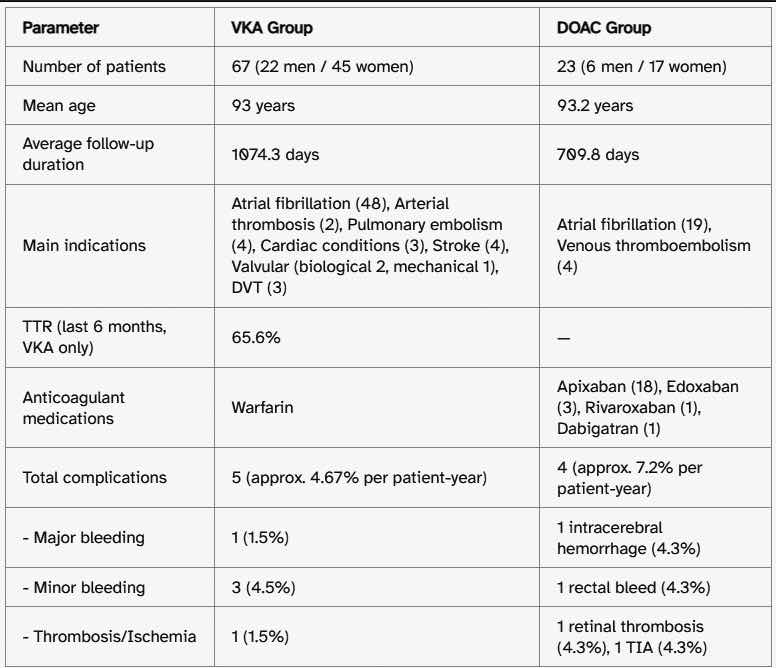Abstracts from the 29^ National Conference of the Italian Society for the Study of Hemostasis and Thrombosis, Bergamo, Italy | 23-25 October 2025
Vol. 4 No. s1 (2025)
PO31 | Comparative analysis of anticoagulant therapy in patients over 90 years old: vitamin K antagonists versus direct oral anticoagulants
G. Sottilotta1, P. Arrigo2, S. Cuzzocrea1, D. Megalizzi1, F. Luise3 | 1UOSD Microcitemie, Emostasi e Trombosi, Grande Ospedale Metropolitano di Reggio Calabria; 2Associazione Italiana Pazienti Anticoagulati, Sezione di Reggio Calabria; 3Laboratorio Analisi. Grande Ospedale Metropolitano di Reggio Calabria, Italy
Publisher's note
All claims expressed in this article are solely those of the authors and do not necessarily represent those of their affiliated organizations, or those of the publisher, the editors and the reviewers. Any product that may be evaluated in this article or claim that may be made by its manufacturer is not guaranteed or endorsed by the publisher.
All claims expressed in this article are solely those of the authors and do not necessarily represent those of their affiliated organizations, or those of the publisher, the editors and the reviewers. Any product that may be evaluated in this article or claim that may be made by its manufacturer is not guaranteed or endorsed by the publisher.
Published: 22 October 2025
354
Views
0
Downloads
Similar Articles
- PO28 | Long term effectiveness and safety of venous thromboembolism with fondaparinux: data from the start registry , Bleeding, Thrombosis and Vascular Biology: Vol. 4 No. s1 (2025)
- PO57 | Direct oral anticoagulant determination in urine samples compared to plasma concentrations in outpatients with atrial fibrillation and obesity , Bleeding, Thrombosis and Vascular Biology: Vol. 4 No. s1 (2025)
- PO89 | Apixaban for secondary prevention of venous thromboembolism in hemodialysis patients: pharmacokinetic profile and safety outcomes , Bleeding, Thrombosis and Vascular Biology: Vol. 4 No. s1 (2025)
- PO29 | Quality of anticoagulation as a predictor of early left ventricular thrombosis resolution: a retrospective cohort study , Bleeding, Thrombosis and Vascular Biology: Vol. 4 No. s1 (2025)
- PO58 | Gender differences in primary haemostasis , Bleeding, Thrombosis and Vascular Biology: Vol. 4 No. s1 (2025)
- PO90 | Acquired hemophilia A with high-titer inhibitor in a patient with cardiovascular and metabolic comorbidities , Bleeding, Thrombosis and Vascular Biology: Vol. 4 No. s1 (2025)
- PO30 | Acquired angioedema associated with B-non Hodgkin lymphoma: a case report , Bleeding, Thrombosis and Vascular Biology: Vol. 4 No. s1 (2025)
- PO59 | Efficacy and safety of different anticoagulant treatment regimens for isolated internal jugular vein thrombosis: a case series , Bleeding, Thrombosis and Vascular Biology: Vol. 4 No. s1 (2025)
- PO91 | Disseminated intravascular coagulation with deep vein thrombosis in a frail patient: an extreme manifestation triggered by sepsis during SGLT2i therapy , Bleeding, Thrombosis and Vascular Biology: Vol. 4 No. s1 (2025)
- PO32 | Effect of the sodium-glucose co-transporter-2 (SGLT2) inhibitors on platelet activation and lipid peroxidation: results of a pilot study , Bleeding, Thrombosis and Vascular Biology: Vol. 4 No. s1 (2025)
1-10 of 96
Next
You may also start an advanced similarity search for this article.











